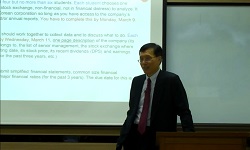In this study, we empirically analyzed the effects of long-term and short-term growth opportunities on book value and market leverage for KOSDAQ-listed companies. In the study, venture companies based on dynamic growth opportunities and non-venture co...
http://chineseinput.net/에서 pinyin(병음)방식으로 중국어를 변환할 수 있습니다.
변환된 중국어를 복사하여 사용하시면 됩니다.
- 中文 을 입력하시려면 zhongwen을 입력하시고 space를누르시면됩니다.
- 北京 을 입력하시려면 beijing을 입력하시고 space를 누르시면 됩니다.

코스닥 벤처기업의 장단기 성장기회와 재무구조 선택에 관한 연구 = A Study on Short and Long-term Growth Opportunities and Financial Structure Selection of KOSDAQ Venture Companies
한글로보기https://www.riss.kr/link?id=A108564613
- 저자
- 발행기관
- 학술지명
- 권호사항
-
발행연도
2023
-
작성언어
Korean
- 주제어
-
등재정보
KCI등재
-
자료형태
학술저널
- 발행기관 URL
-
수록면
335-355(21쪽)
- 제공처
-
0
상세조회 -
0
다운로드
부가정보
다국어 초록 (Multilingual Abstract)
In this study, we empirically analyzed the effects of long-term and short-term growth opportunities on book value and market leverage for KOSDAQ-listed companies. In the study, venture companies based on dynamic growth opportunities and non-venture companies were divided into venture companies and non-venture companies. First, it was confirmed that long-term growth opportunities follow the capital order theory, showing a positive (+) relationship with book value leverage, and a negative (-) relationship with market price leverage, showing results consistent with the static trade-off theory. However, short-term growth opportunities did not show significance with book value leverage, and showed a significant positive (+) relationship with market leverage, confirming that the order theory of capital raising was supported. In other words, the financial structure of KOSDAQ companies is interpreted to support different theories according to short- and long-term growth opportunities. Second, in the results of classification into venture and non-venture, the book value leverage and short- and long-term growth opportunities showed a positive (+) relationship in venture companies and short-term growth opportunities in non-venture companies, respectively, and market leverage showed opposite signs between long and short-term growth opportunities. showed a relationship This seems to be consistent with the theory that growth opportunities exist differently depending on the characteristics of the company, and depending on the value of leverage. Third, in the analysis by growth group, the relationship between long-term and short-term growth opportunities and leverage differs between venture companies and non-venture companies, and also differs according to the level of growth opportunities.
국문 초록 (Abstract)
본 연구에서는 코스닥 상장기업을 대상으로 장기성장기회와 단기성장기회가 장부가레버리지와 시장가레버리지에 미치는 영향을 실증분석하였다. 연구에서는 역동적 성장기회를 기반으로 ...
본 연구에서는 코스닥 상장기업을 대상으로 장기성장기회와 단기성장기회가 장부가레버리지와 시장가레버리지에 미치는 영향을 실증분석하였다. 연구에서는 역동적 성장기회를 기반으로 하는 벤처기업과 비벤처기업으로 나누어 실시하였으며, 어떤 재무구조 이론이 성장기회와 레버리지의 관계에 부합하는지를 검증하고자 하였다. 첫째, 장기성장기회가 장부가레버리지와 정(+)의 관계를 보이면서 자본조달 순서이론을 따르는 것으로 확인되었고 시장가레버리지와는 부(-)의 관계를 보이고 있어 정태적상충이론에 부합하는 결과를 보였다. 그러나 단기성장기회는 장부가레버리지와 유의성이 나타나지 않았으며, 시장가레버리지에서 유의한 정(+)의 관계를 보여 자본조달순서이론이 지지됨을 확인하였다. 즉 코스닥기업의 재무구조는 장단기 성장기회에 따라서 다른 이론을 지지하는 것으로 해석된다. 둘째, 벤처기업과비벤처기업으로 분류한 결과에서 장부가레버리지와 장단기 성장기회는 벤처기업에서, 단기성장기회는 비벤처기업에서 각각 정(+)의 관계가 나타났고 시장가레버리지는 장단기 성장기회 간에 상반된 부호 관계를 보였다. 이는 성장기회가 기업특성에 따라 다르게 존재하며, 레버리지의 가치에 따라서 다른 이론에 부합되는 것으로 보인다. 셋째, 성장그룹별 분석에서는 장단기 성장기회가 레버리지에 미치는 관계는 벤처기업과 비벤처기업 간에 차이가 있으며, 성장기회의 수준에 따라서도 다르게 나타났다.
참고문헌 (Reference)
1 김부민 ; 이유경 ; 이은정, "한국 상장기업의 자본구조에 관한 재고찰: 상충관계이론 VS. 자본조달순위이론" 한국증권학회 44 (44): 373-412, 2015
2 윤봉한, "한국 상장기업의 자본구조 결정요인에 대한 장기분석:정태적 절충모델과 자본조달순위모델간의 비교" 한국경영학회 34 (34): 973-1000, 2005
3 오세경 ; 김우성, "한국 상장기업의 성장기회와 자본구조 선택에 관한 실증연구" 한국재무학회 25 (25): 123-160, 2012
4 김석진 ; 박민규, "자금부족분을 이용한 자본조달순서이론 검정" 한국경영학회 34 (34): 1829-1852, 2005
5 라영수, "우리나라 중소기업의 자본구조에 관한 연구 : KOSDAQ 대기업과 비교 연구1" 한국산업경제학회 35 (35): 307-328, 2022
6 구본일 ; 엄영호 ; 전효찬, "우리나라 기업의 자본구조에 관한 연구 : 절충이론과 순서이론의 비교" 한국경제의 분석패널 14 (14): 1-60, 2008
7 이장우, "성장옵션과 부채조달정책에 관한 실증연구" 한국금융공학회 5 (5): 117-135, 2006
8 김문겸 ; 김순철, "성장기회가 재무정책에 미치는 영향에 관한 연구:KOSDAQ 중소기업을 중심으로" 한국중소기업학회 29 (29): 173-200, 2007
9 우원석 ; 최형석, "성장기업의 자금조달에 관한 연구" 한국증권학회 44 (44): 595-614, 2015
10 김문겸, "비상장.비등록 중소기업의 재무레버리지 결정에 관한 연구" 한국재무관리학회 19 (19): 33-66, 2002
1 김부민 ; 이유경 ; 이은정, "한국 상장기업의 자본구조에 관한 재고찰: 상충관계이론 VS. 자본조달순위이론" 한국증권학회 44 (44): 373-412, 2015
2 윤봉한, "한국 상장기업의 자본구조 결정요인에 대한 장기분석:정태적 절충모델과 자본조달순위모델간의 비교" 한국경영학회 34 (34): 973-1000, 2005
3 오세경 ; 김우성, "한국 상장기업의 성장기회와 자본구조 선택에 관한 실증연구" 한국재무학회 25 (25): 123-160, 2012
4 김석진 ; 박민규, "자금부족분을 이용한 자본조달순서이론 검정" 한국경영학회 34 (34): 1829-1852, 2005
5 라영수, "우리나라 중소기업의 자본구조에 관한 연구 : KOSDAQ 대기업과 비교 연구1" 한국산업경제학회 35 (35): 307-328, 2022
6 구본일 ; 엄영호 ; 전효찬, "우리나라 기업의 자본구조에 관한 연구 : 절충이론과 순서이론의 비교" 한국경제의 분석패널 14 (14): 1-60, 2008
7 이장우, "성장옵션과 부채조달정책에 관한 실증연구" 한국금융공학회 5 (5): 117-135, 2006
8 김문겸 ; 김순철, "성장기회가 재무정책에 미치는 영향에 관한 연구:KOSDAQ 중소기업을 중심으로" 한국중소기업학회 29 (29): 173-200, 2007
9 우원석 ; 최형석, "성장기업의 자금조달에 관한 연구" 한국증권학회 44 (44): 595-614, 2015
10 김문겸, "비상장.비등록 중소기업의 재무레버리지 결정에 관한 연구" 한국재무관리학회 19 (19): 33-66, 2002
11 신민식 ; 김수은, "레버리지, 부채만기 및 투자간의 상호관계와 이들과 성장기회간의 상호작용이 레버리지, 부채만기 및 투자에 미치는 영향" 한국경영학회 41 (41): 1021-1056, 2012
12 신용재, "기업특성이 자본구조에 미치는 영향에 관한 연구: 비상장 중소기업을 대상으로" 대한경영학회 28 (28): 675-695, 2015
13 주병철 ; 박성태, "국내 식품산업의 기업규모 및 산업유형 간자본조달에 관한 실증연" 한국산업경제학회 31 (31): 153-180, 2018
14 Graham, J. R., "The theory and practice of corporate finance:Evidence from the field" 60 (60): 187-243, 2001
15 Chaplinsky, S., "The tax and distributional effects of leveraged ESOPs" 29-38, 1990
16 Adam, T., "The investment opportunity set and its proxy variables" 31 (31): 41-63, 2008
17 Smith Jr, C. W., "The investment opportunity set and corporate financing, dividend, and compensation policies" 32 (32): 263-292, 1992
18 Ross, S. A., "The determination of financial structure: the incentive-signalling approach" 23-40, 1977
19 Titman, S., "The determinants of capital structure choice" 43 (43): 1-19, 1988
20 Marsh, P., "The choice between equity and debt : An empirical study" 37 (37): 121-144, 1982
21 Barclay, M. J., "The capital structure puzzle : The evidence revisited" 17 (17): 8-17, 2005
22 Ang, J. S., "The administrative costs of corporate bankruptcy : A note" 37 (37): 219-226, 1982
23 Fama, E. F., "Testing trade-off and pecking order predictions about dividends and debt" 15 (15): 1-33, 2002
24 Frank, M. Z., "Testing the pecking order theory of capital structure" 67 (67): 217-248, 2003
25 Shyam-Sunder, L., "Testing static tradeoff against pecking order models of capital structure" 51 (51): 219-244, 1999
26 Flannery, M. J., "Partial adjustment to public information in the foreign exchange market" 61 (61): 2687-2716, 2006
27 Long, M. S., "Investment patterns and financial leverage. In Corporate capital structures in the United States" University of Chicago Press 325-352, 1985
28 Sogorb-Mira, F., "How SME uniqueness affects capital structure : Evidence from a 1994–1998 Spanish data panel" 25 (25): 447-457, 2005
29 De Jong, A., "Firms’ debt–equity decisions when the static tradeoff theory and the pecking order theory disagree" 35 (35): 1303-1314, 2011
30 Michaelas, N., "Financial policy and capital structure choice in UK SMEs : Empirical evidence from company panel data" 12 (12): 113-130, 1999
31 Myers, S. C., "Finance theory and financial strategy" 14 (14): 126-137, 1984
32 Goyal, M., "Economic and health consequences of selling a kidney in India" 288 (288): 1589-1593, 2002
33 Hall, G., "Determinants of the capital structure of European SMEs" 31 (31): 711-728, 2004
34 Van der Wijst, N., "Determinants of small firm debt ratios : An analysis of retail panel data" 5 : 55-65, 1993
35 Ozkan, G., "Determinants of foreign direct investment inflows to developing countries : a cross-sectional analysis" 3 (3): 79-102, 2001
36 Myers, S. C., "Determinants of corporate borrowing" 5 (5): 147-175, 1977
37 Myers, S. C., "Corporate financing and investment decisions when firms have information that investors do not have" 13 (13): 187-221, 1984
38 Cassar, G., "Capital structure and financing of SMEs : Australian evidence" 43 (43): 123-147, 2003
39 Warner, J. B., "Bankruptcy costs : Some evidence" 32 (32): 337-347, 1977
40 Stulz, R., "An analysis of secured debt" 14 (14): 501-521, 1985
41 Perfect, S. B., "Alternative constructions of Tobin's q: An empirical comparison" 1 (1): 313-341, 1994
42 Jensen, M. C., "Agency costs of free cash flow, corporate finance, and takeovers" 76 (76): 323-329, 1986
43 Gaver, J. J., "Additional evidence on the association between the investment opportunity set and corporate financing, dividend, and compensation policies" 16 (16): 125-160, 1993
동일학술지(권/호) 다른 논문
-
전자정부서비스 이용기기와 전자정부서비스 만족도와의 관계에 대한 연구
- 한국산업경제학회
- 이향수
- 2023
- KCI등재
-
- 한국산업경제학회
- 박성훈
- 2023
- KCI등재
-
- 한국산업경제학회
- 김희연
- 2023
- KCI등재
-
- 한국산업경제학회
- 유시아
- 2023
- KCI등재




 DBpia
DBpia




